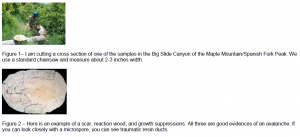Kimball Hansen and Dr. Matthew Bekker, Department of Geography
I began planning my project of the avalanche chronology of the Maple Mountain/Spanish Fork Peak Avalanche Paths in 2009 while applying for the ORCA grant. I was currently wrapping up a similar project of an avalanche chronology of Loafer Mountain near Woodland Hills Peak. This later project helped form a basis for the new avalanche path near Spanish Fork Peak. Since the two paths are relatively close to each other in the Wasatch Mountain Range, I can use the chronology found from Loafer Mountain avalanche path with the new path I will be researching and correlate the data and help eliminate discrepancies.
Field collection began in May 2011. We had to wait for the snow to melt after one of the wettest winters recorded in Utah history. We also surveyed Spanish Fork Peak prior to data collection and found four potential avalanche paths to research; Crowd Canyon, Big Slide Canyon, Middle Slide Canyon, and Little Slide Canyon. When we traversed Crowd Canyon we found some good samples but had to hike pretty far to get to them. After searching Big Slide, Middle Slide, and Little Slide Canyon, we decided to work with Big Slide Canyon first because it contained a great number of samples that were easily within reach and we could begin working and collecting data right away. We found plenty of logs that had been brought down in a previous avalanche. The samples looked to be in poor to decent condition. It seemed that they had been there for several years and started rotting. But they were still reasonable so we took out the chainsaw and cut up cross sections of the log to take back to the laboratory. We will traverse the other three canyons of Maple Mountain in future excursions. We collected the samples on two separate occasions and gathered about 20 total samples to analyze.
Once we collected a good amount of samples, we took them back to our laboratory and I began to prepare the cross sections for analysis. I first planed the samples with a hand planer. Then I sanded them with progressively finer grits of sandpaper from 36 grit – 9 Micron. Dr. Bekker and I were hoping that after preparing our samples we could correlate them with the avalanche on Loafer Mountain. This would make it easier to date our new samples because the date of the death of the trees is unknown.
That was where we ran into unexpected problems. Our new samples have very complacent tree rings. This means that there aren’t a whole lot of growth suppressions or releases. The size of the rings is generally the same. When we have these types of rings, (several narrow or wide) we are able to correlate them with other rings in different sampling sites. This helps us to begin dating the undated samples. Since our rings are very complacent for this new site, we couldn’t date them right away based on the narrow and wide rings. Our new samples have a lot of scars from the avalanches which do indicate that several avalanches previous occurred in the path. When an avalanche roars down a mountain, debris, ice, and rocks hit and knock over trees which produce scars. But we can’t really just compare scars to scars for dating. Ring width is much more effective. We can also look at reaction wood. Reaction wood is when the coniferous tree gets tilted during an avalanche, and the downward slope of the tree grows larger, yellow-color rings to push the tree back upright.
Now we will begin to measure each ring for all the samples and put that data into our software program, COFECHA and J2X, to determine if it can find correlations to date them with other avalanche paths. This is the part that we are now at with our research. We had planned to be finished dating our samples by now, but because of the problems that occurred, we are a little behind schedule. This is OK though. We will still need to collect more samples for this summer and hopefully be able to present at the AAG regional conference for the upcoming fall semester at BYU and other conferences next winter semester in 2013. We hope to publish the results of our paper in a scholarly journal at the end of 2013.
We are currently researching another method of study of dendrochronology for analyzing avalanches. We generally look at scars, growth suppressions and releases, and reaction wood to find evidences of avalanches. When an avalanche occurs, the tree goes through stress and releases resin in the rings. This is called Traumatic Resin Ducts (TRD’s). After researching other scholarly journals, we have learned that after impact the tree can release these TRD’s for several years. We are in the process of determining if we will use this method for dating avalanches.
I presented the Loafer Mountain report at the Fulton Conference on April 5, 2012. Since I finished this research project, I displayed the results at this Conference. I will present the results of the Maple Mountain/Spanish Fork Peak Avalanche Path research project during next year’s Fulton Conference in 2013.
I want to thank ORCA for allowing me the opportunity to have the means for carrying out this research project. Also I want to thank my mentor, Dr. Bekker for guiding and instructing me during the process.

